Family: Tenthredinidae
Family common name: common sawflies
Subfamily: Nematinae
Tribe: Nematini
Genus: Hemichroa Stephens, 1835
Subgenera: none
The Tenthredinidae are the most species-rich family and are found throughout the world, in all continents but Antarctica. They are known as the “common sawflies.” They can generally be recognized by a cylindrical body and long, segmented antennaeantenna:
the sensory organ emerging from the front of the head, usually between the compound eyes and above the clypeus; includes the flagellum, scape and pedicel
 . Otherwise, they come in a variety of colors, sizes, and forms (Goulet 1992Goulet 1992:
. Otherwise, they come in a variety of colors, sizes, and forms (Goulet 1992Goulet 1992:
Goulet H. 1992. The genera and subgenera of the sawflies of Canada and Alaska: Hymenoptera. Symphyta. The insects and arachnids of Canada. Part 20. Agriculture Canada Publication.).
Nematinae is the second-largest subfamily of Tenthredinidae, with over 1,250 species (Prous et al. 2014Prous et al. 2014:
Prous M, Blank SM, Goulet H, Heibo E, Liston A, Malm T, Nyman T, Schmidt S, Smith DR, Varing;rdal H, Viitasaari M, Vikberg V, and Taeger A. 2014. The genera of Nematinae (Hymenoptera, Tenthredinidae). Journal of Hymenoptera Research 40: 1-69. " target="_blank">https://doi.org/10.3897/JHR.40.7442). They are most diverse in northern Eurasia and North America; only a few species occur in the Southern Hemisphere. Nematinae sawflies have a variety of feeding habits including external leaf feeding, leaf mining, and gall forming, and feed on a variety of hosts (Smith 2003bSmith 2003b:
Smith DR. 2003b. A Synopsis of the sawflies (Hymenoptera: Symphyta) of America south of the United States: Tenthredinidae (Nematinae, Heterarthrinae, Tenthredininae). Transactions of the American Entomological Society 129 (1): 1-45.).
The Nematinae have been subject to numerous revisions in recent years. As of 2021, there are no comprehensive keys to many of the North American species of Nematinae (Prous et al. 2014Prous et al. 2014:
Prous M, Blank SM, Goulet H, Heibo E, Liston A, Malm T, Nyman T, Schmidt S, Smith DR, Varing;rdal H, Viitasaari M, Vikberg V, and Taeger A. 2014. The genera of Nematinae (Hymenoptera, Tenthredinidae). Journal of Hymenoptera Research 40: 1-69. " target="_blank">https://doi.org/10.3897/JHR.40.7442). Because of changing taxonomy and extreme variability in morphology, identifying genera and species in the Nematinae may be more challenging than in other subfamilies of Tenthredindae. For this reason, knowing the host or behaviors of a specimen can be extremely helpful for identification within this subfamily.
Hemichroa is represented in North America only by a single, introduced pest species. Hemichroa crocea females are bright orange, while the males are mostly black with orange legs (Smith 1975Smith 1975:
Smith DR. 1975. The sawfly genus Hemichroa Stephens : A review of species (Hymenoptera: Tenthredinidae). Insect Systematics and Evolution 6 (3-4): 297-302. https://doi.org/10.1163/187631275X00145).
There are 11 described species worldwide. One species occurs in North America (Taeger et al. 2018Taeger et al. 2018:
Taeger A, Liston AD, Prous M, Groll EK, Gehroldt T, and Blank SM. 2018. ECatSymmdash;Electronic World Catalog of Symphyta (Insecta, Hymenoptera). Program version 5.0 (19 Dec 2018), data version 40 (23 Sep 2018). Senckenberg Deutsches Entomologisches Institut (SDEI), Muuml;ncheberg. https://sdei.de/ecatsym/ Accessed: 28 Jan 2020.).
Subfamily characters
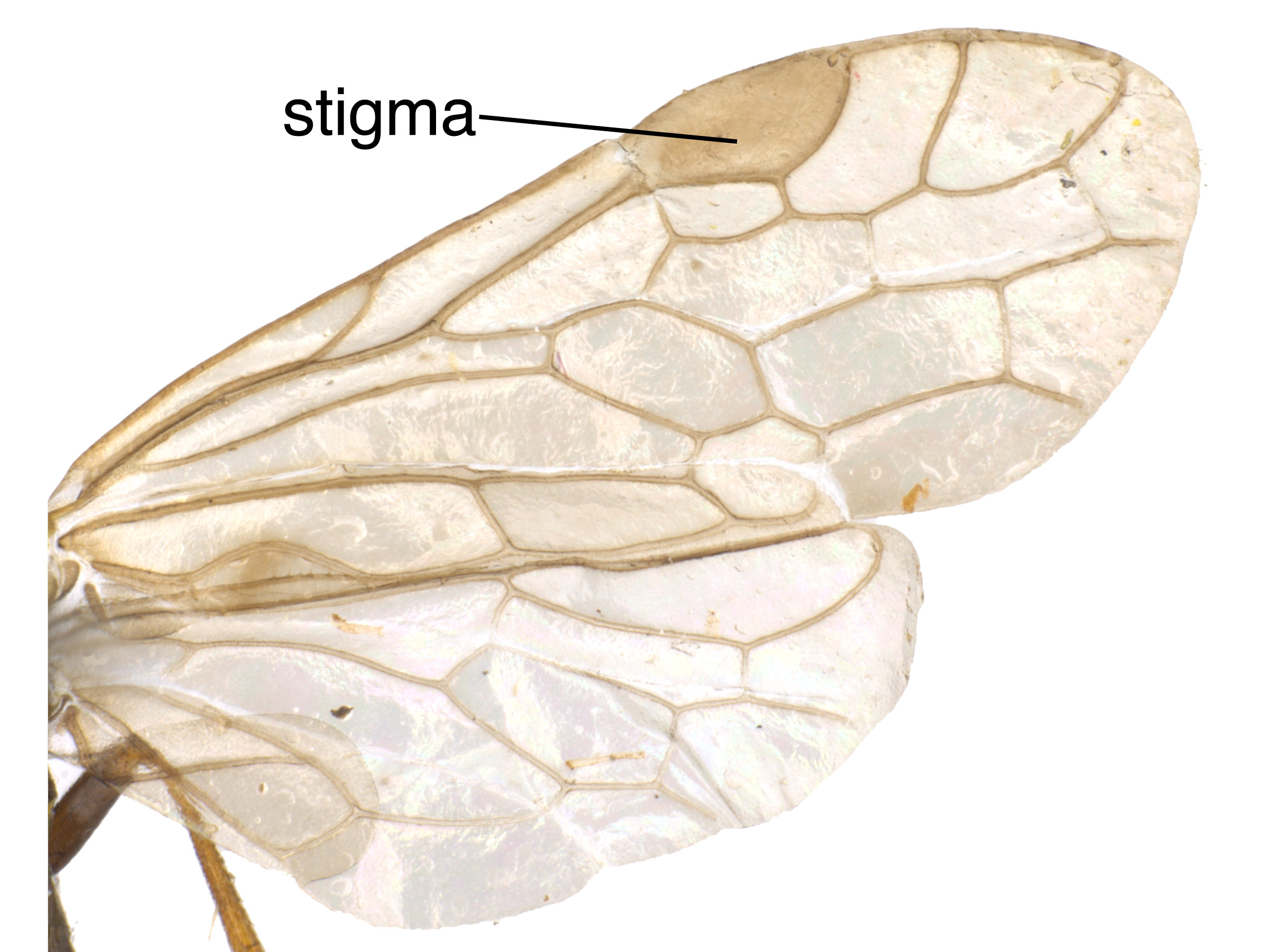 (Goulet 1992Goulet 1992:
(Goulet 1992Goulet 1992: vein 2m-cu meeting cellcell:
vein 2m-cu meeting cellcell: 1Rs above (Goulet 1992Goulet 1992:
1Rs above (Goulet 1992Goulet 1992:Genus characters
 deeply emarginated (Prous et al. 2014Prous et al. 2014:
deeply emarginated (Prous et al. 2014Prous et al. 2014: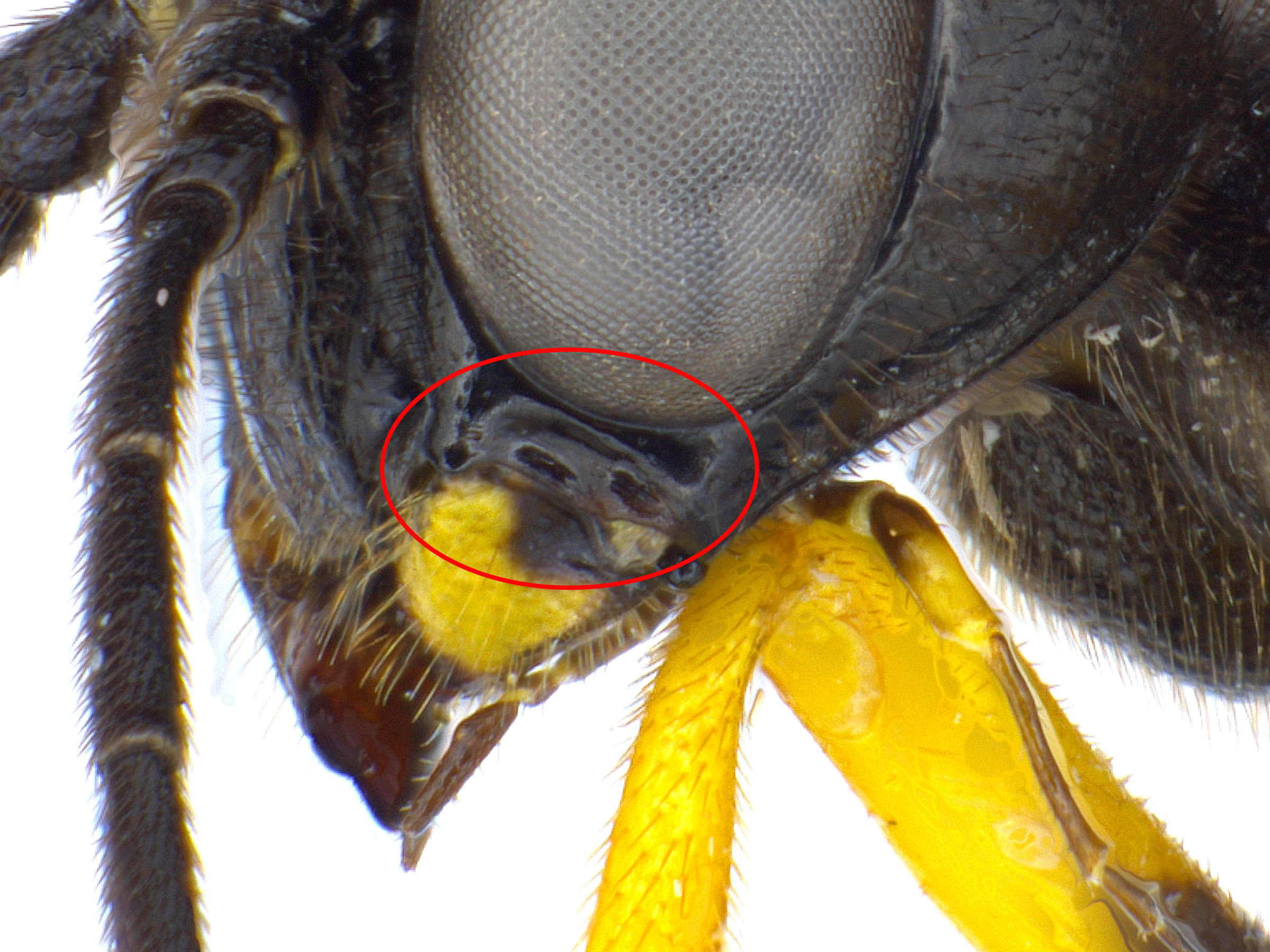 about equal to diameter of front ocellusocellus:
about equal to diameter of front ocellusocellus: (Prous et al. 2014Prous et al. 2014:
(Prous et al. 2014Prous et al. 2014: wider than long (Smith 1975Smith 1975:
wider than long (Smith 1975Smith 1975: about equal to third (Goulet 1992Goulet 1992:
about equal to third (Goulet 1992Goulet 1992: veins M and Rs+M relatively widely separated on veinvein:
veins M and Rs+M relatively widely separated on veinvein: R (Goulet 1992Goulet 1992:
R (Goulet 1992Goulet 1992: vein 2A+3A curved upwards and meeting 1A (Goulet 1992Goulet 1992:
vein 2A+3A curved upwards and meeting 1A (Goulet 1992Goulet 1992: vein 2r-rs present (Prous et al. 2014Prous et al. 2014:
vein 2r-rs present (Prous et al. 2014Prous et al. 2014: vein 2A meeting 1A; basalbasal:
vein 2A meeting 1A; basalbasal: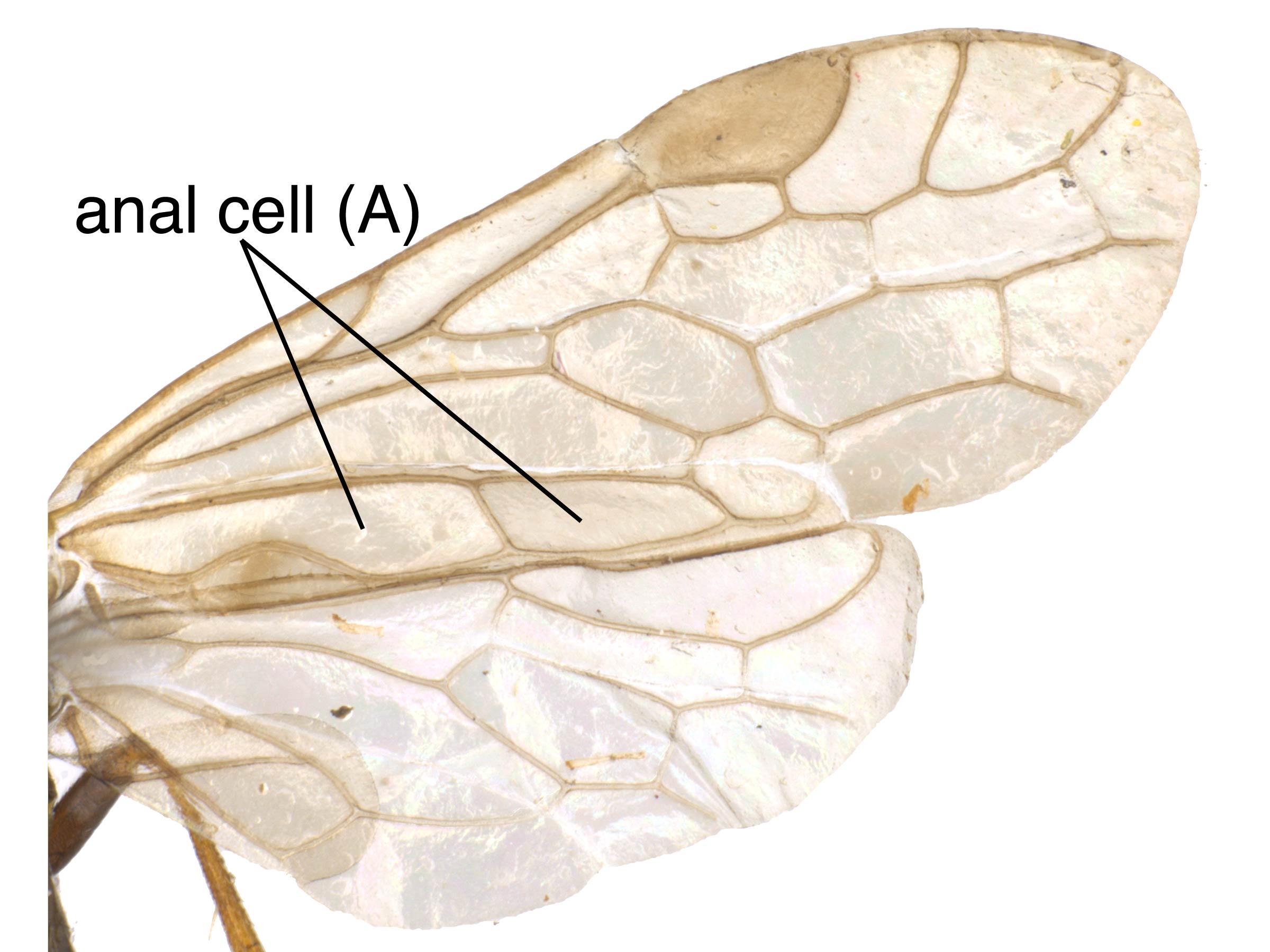 present (Goulet 1992Goulet 1992:
present (Goulet 1992Goulet 1992: spur with velum (Goulet 1992Goulet 1992:
spur with velum (Goulet 1992Goulet 1992: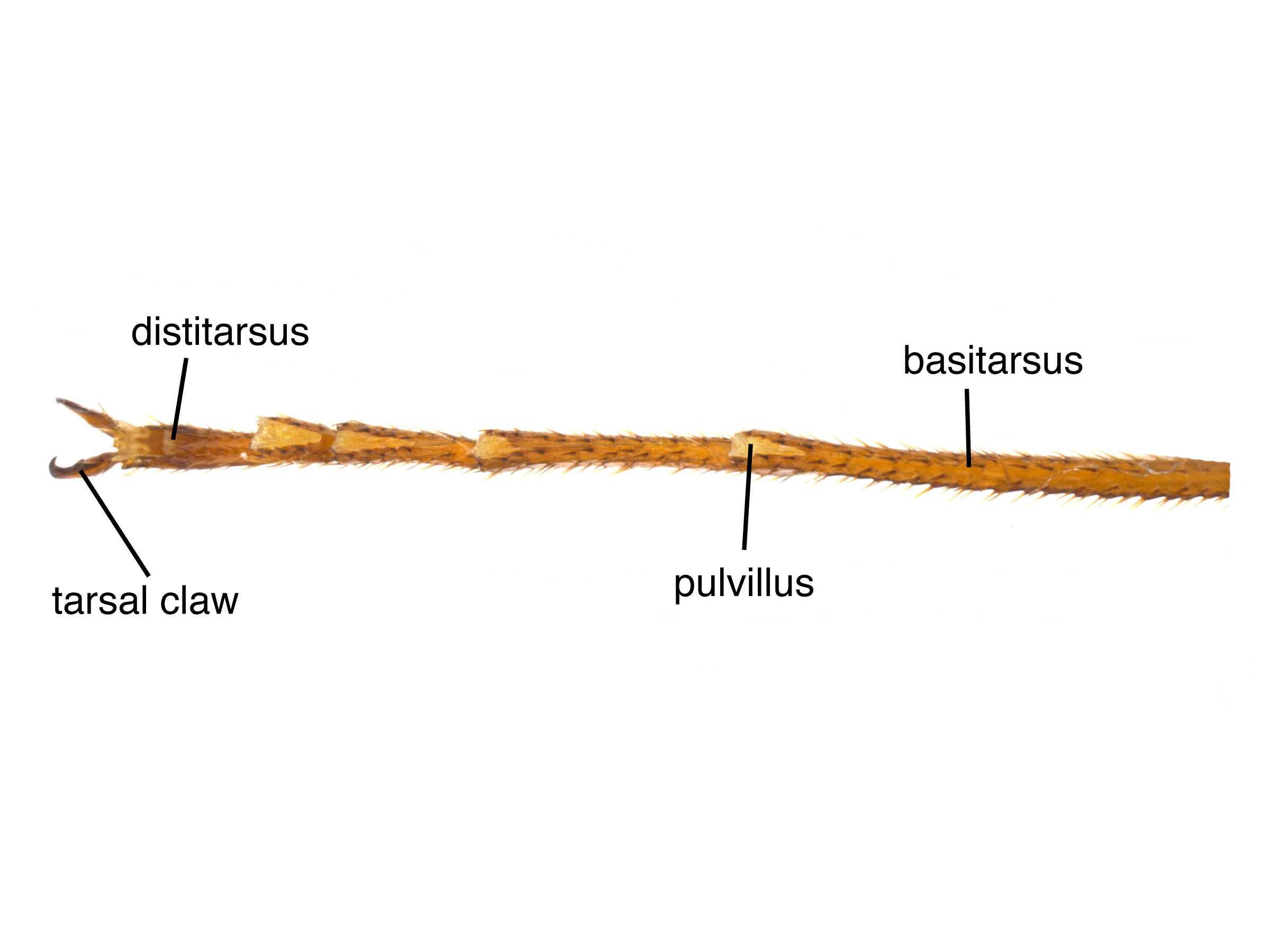 about 1/3 the length of the tarsomeretarsomere:
about 1/3 the length of the tarsomeretarsomere: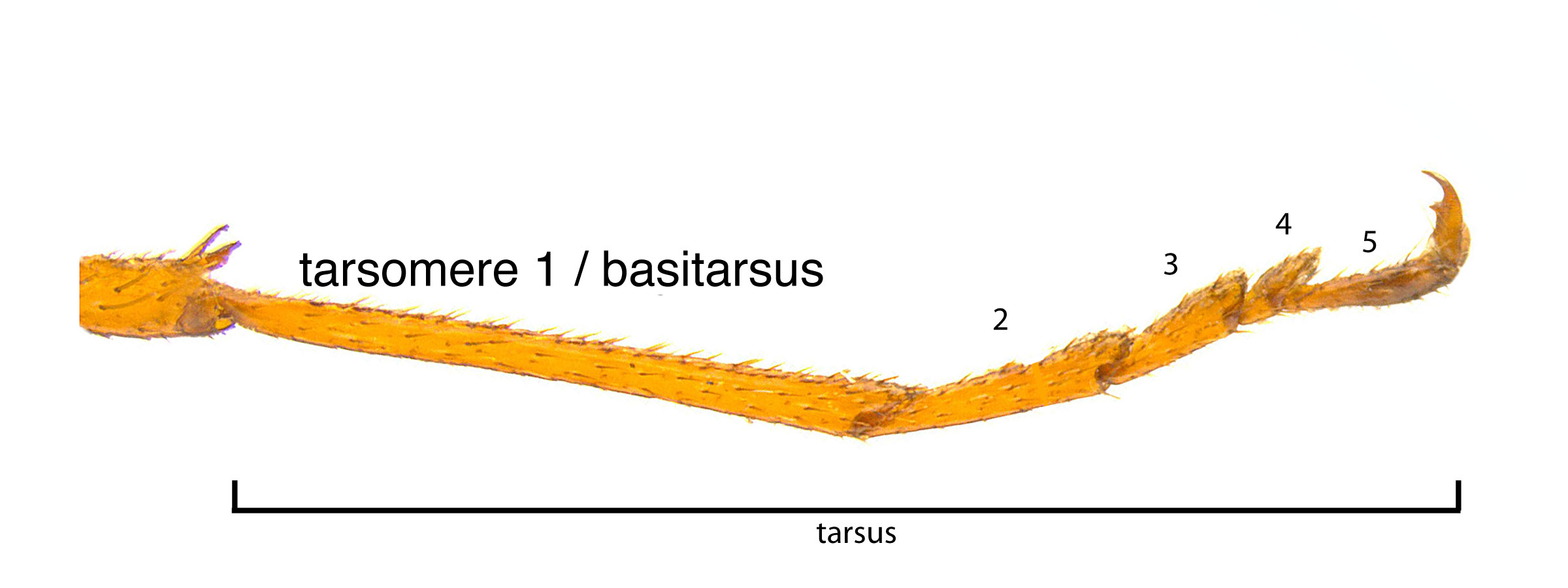 (Goulet 1992Goulet 1992:
(Goulet 1992Goulet 1992: about 3–6X as long as wide (Goulet 1992Goulet 1992:
about 3–6X as long as wide (Goulet 1992Goulet 1992:Hemichroa can be distinguished from other genera of Nematinae that have fore wingfore wing:
the anterior wing of each pair of wings; usually the largest wing of the pair
 vein 2A+3A curved upwards and veinvein:
vein 2A+3A curved upwards and veinvein:
a tube-like, often darkened, structure on the wings
 2r-rs present by the long, slender antennaeantenna:
2r-rs present by the long, slender antennaeantenna:
the sensory organ emerging from the front of the head, usually between the compound eyes and above the clypeus; includes the flagellum, scape and pedicel
 , short pulvillipulvillus:
, short pulvillipulvillus:
soft pads used for surface adhesion, located in sawflies on the first 4 segments of the tarsus
 , and long inner tooth of the tarsal clawtarsal claw:
, and long inner tooth of the tarsal clawtarsal claw:
sharpened appendage emerging from the apex of the tarsus
 (Smith 1975Smith 1975:
(Smith 1975Smith 1975:
Smith DR. 1975. The sawfly genus Hemichroa Stephens : A review of species (Hymenoptera: Tenthredinidae). Insect Systematics and Evolution 6 (3-4): 297-302. https://doi.org/10.1163/187631275X00145, Goulet 1992Goulet 1992:
Goulet H. 1992. The genera and subgenera of the sawflies of Canada and Alaska: Hymenoptera. Symphyta. The insects and arachnids of Canada. Part 20. Agriculture Canada Publication.).
none
Hemichroa crocea feeds primarily on Alnus (alder), but may also feed on Betula (birch), Corylus (hazel), and Salix (willow) (Saini and Vasu 2004Saini and Vasu 2004:
Saini MS and Vasu V. 2004. Review of the genus Hemichroa Stephens (Hymenoptera: Symphyta: Tenthredinidae: Nematinae) from the Oriental Region. Zoos#39; Print Journal 19 (6): 1487-1491.).
Hemichroa crocea, known as the striped alder sawfly, is an introduced pest of alder. The larvaelarva:
the immature stage of holometabolous insects
 feed gregariously on the margin of the leaf. At maturity, the larvaelarva:
feed gregariously on the margin of the leaf. At maturity, the larvaelarva:
the immature stage of holometabolous insects
 fall to the ground to pupate or overwinter in the soil. This species undergoes up to three generations per year (Smith 1975Smith 1975:
fall to the ground to pupate or overwinter in the soil. This species undergoes up to three generations per year (Smith 1975Smith 1975:
Smith DR. 1975. The sawfly genus Hemichroa Stephens : A review of species (Hymenoptera: Tenthredinidae). Insect Systematics and Evolution 6 (3-4): 297-302. https://doi.org/10.1163/187631275X00145).
Hemichroa crocea react when disturbed by erratically moving the abdominal portion of the body, and sometimes by hiding on the other side of the leaf. Interestingly, H. crocea also have a unique larval behavior that involves rubbing protuberances on their body against the leaf to make sound. This may work as a vibrational signal to nearby larvaelarva:
the immature stage of holometabolous insects
 that food is plentiful in their location or may be an additional defensive behavior (Boevé 2015).
that food is plentiful in their location or may be an additional defensive behavior (Boevé 2015).
World: The genus is known from North America, throughout Europe, and in India, Nepal, China, Japan, and Korea (Saini and Vasu 2004Saini and Vasu 2004:
Saini MS and Vasu V. 2004. Review of the genus Hemichroa Stephens (Hymenoptera: Symphyta: Tenthredinidae: Nematinae) from the Oriental Region. Zoos#39; Print Journal 19 (6): 1487-1491., Taeger et al. 2018Taeger et al. 2018:
Taeger A, Liston AD, Prous M, Groll EK, Gehroldt T, and Blank SM. 2018. ECatSymmdash;Electronic World Catalog of Symphyta (Insecta, Hymenoptera). Program version 5.0 (19 Dec 2018), data version 40 (23 Sep 2018). Senckenberg Deutsches Entomologisches Institut (SDEI), Muuml;ncheberg. https://sdei.de/ecatsym/ Accessed: 28 Jan 2020.).
North America: Hemichroa crocea was introduced from Europe and first discovered in British Columbia in 1932 (Hopping 1937Hopping 1937:
Hopping GR. 1937. Sawfly biologies no. 2, Hemichroa crocea Geoffroy. Canadian Entomologist 69 (11): 243-249.). The species is now established in Canada and the northern United States, as far north as Alaska; in the west it occurs farther south in Colorado and New Mexico (Smith 1975Smith 1975:
Smith DR. 1975. The sawfly genus Hemichroa Stephens : A review of species (Hymenoptera: Tenthredinidae). Insect Systematics and Evolution 6 (3-4): 297-302. https://doi.org/10.1163/187631275X00145).
Map data from: GBIF.org (29 October 2019) GBIF Occurrence Download Hemichroa
Details about data used for maps can be found here.